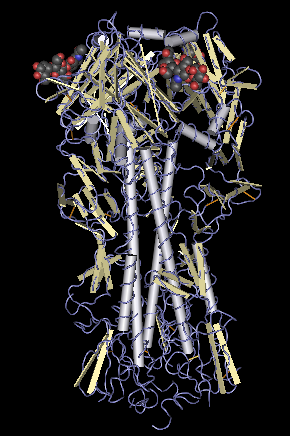Molecular graphics
Molecular graphics is the discipline within computational chemistry, bioinformatics, and molecular biology that uses three-dimensional (3D) visual representations of molecular structure to analyze and communicate molecular data and concepts. The primary goal of molecular graphics is to aid in the understanding of the structure, dynamics, and function of molecules, especially large biomolecules such as proteins, nucleic acids, and lipids.
Overview[edit | edit source]
Molecular graphics tools enable scientists to visualize complex molecular structures in 3D, facilitating a deeper understanding of the molecular basis of biological processes and chemical interactions. These tools range from simple models that represent atoms as spheres and bonds as sticks to sophisticated software capable of simulating molecular dynamics and interactions in real-time.
History[edit | edit source]
The history of molecular graphics dates back to the early 20th century, with the development of physical models to represent molecules. However, the field truly began to evolve with the advent of computer technology, which allowed for the creation of digital 3D models of molecules. The 1960s and 1970s saw significant advancements in computer graphics technology, enabling more detailed and accurate representations of molecular structures.
Applications[edit | edit source]
Molecular graphics is used in various scientific disciplines, including drug discovery, where it plays a crucial role in the design of new pharmaceuticals by allowing researchers to visualize and manipulate the 3D structure of drug targets and potential ligands. In structural biology, molecular graphics is essential for interpreting the structure and function of biomolecules obtained through techniques such as X-ray crystallography, NMR spectroscopy, and cryo-electron microscopy.
Software[edit | edit source]
A wide range of software tools is available for molecular graphics, from open-source programs like PyMOL and Jmol to commercial packages such as Chimera and VMD. These tools vary in their capabilities, from basic visualization to advanced features like energy minimization, molecular dynamics simulation, and quantum mechanical calculations.
Challenges and Future Directions[edit | edit source]
Despite its advancements, molecular graphics faces challenges, particularly in accurately representing dynamic processes and large biomolecular complexes. Future developments are likely to focus on improving the realism and predictive power of molecular simulations, integrating data from multiple sources, and enhancing the user experience through immersive technologies like virtual reality (VR).
See Also[edit | edit source]
Search WikiMD
Ad.Tired of being Overweight? Try W8MD's physician weight loss program.
Semaglutide (Ozempic / Wegovy and Tirzepatide (Mounjaro / Zepbound) available.
Advertise on WikiMD
|
WikiMD's Wellness Encyclopedia |
| Let Food Be Thy Medicine Medicine Thy Food - Hippocrates |
Translate this page: - East Asian
中文,
日本,
한국어,
South Asian
हिन्दी,
தமிழ்,
తెలుగు,
Urdu,
ಕನ್ನಡ,
Southeast Asian
Indonesian,
Vietnamese,
Thai,
မြန်မာဘာသာ,
বাংলা
European
español,
Deutsch,
français,
Greek,
português do Brasil,
polski,
română,
русский,
Nederlands,
norsk,
svenska,
suomi,
Italian
Middle Eastern & African
عربى,
Turkish,
Persian,
Hebrew,
Afrikaans,
isiZulu,
Kiswahili,
Other
Bulgarian,
Hungarian,
Czech,
Swedish,
മലയാളം,
मराठी,
ਪੰਜਾਬੀ,
ગુજરાતી,
Portuguese,
Ukrainian
Medical Disclaimer: WikiMD is not a substitute for professional medical advice. The information on WikiMD is provided as an information resource only, may be incorrect, outdated or misleading, and is not to be used or relied on for any diagnostic or treatment purposes. Please consult your health care provider before making any healthcare decisions or for guidance about a specific medical condition. WikiMD expressly disclaims responsibility, and shall have no liability, for any damages, loss, injury, or liability whatsoever suffered as a result of your reliance on the information contained in this site. By visiting this site you agree to the foregoing terms and conditions, which may from time to time be changed or supplemented by WikiMD. If you do not agree to the foregoing terms and conditions, you should not enter or use this site. See full disclaimer.
Credits:Most images are courtesy of Wikimedia commons, and templates, categories Wikipedia, licensed under CC BY SA or similar.
Contributors: Prab R. Tumpati, MD





